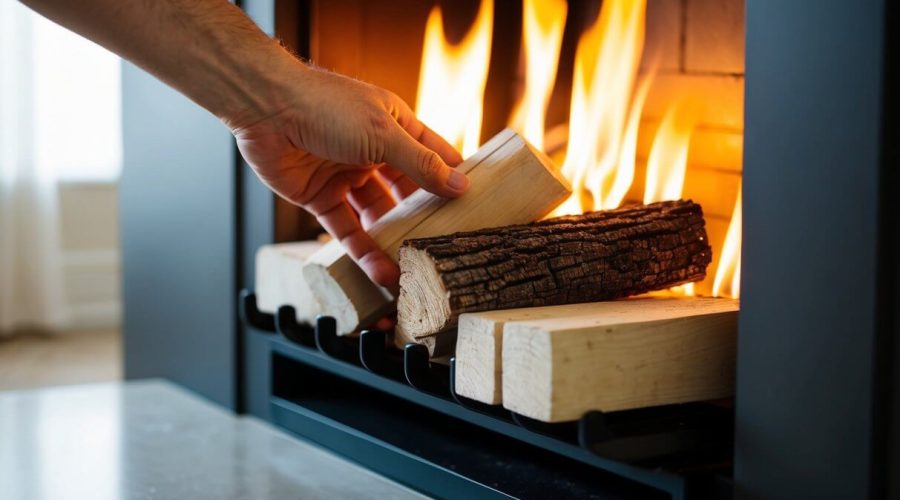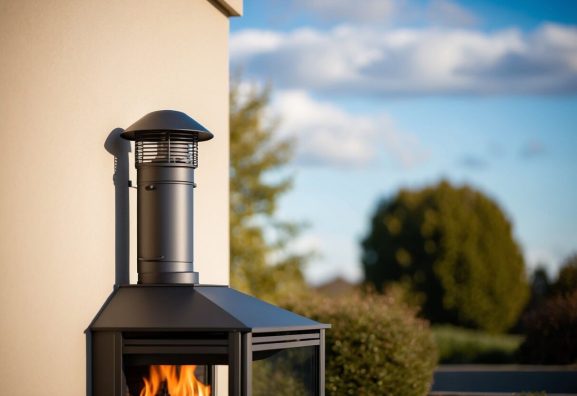When to Replace Gas Fireplace Logs (Key Signs)
Gas fireplaces provide warmth and ambiance, but like any appliance, they require maintenance over time. Log replacement is generally necessary every 10 to 12 years for vented fireplaces and more frequently for ventless models, which may need new logs every 3 to 5 years. Being attentive to the signs of wear will ensure that the fireplace remains safe and efficient.
Homeowners should look for cracks, discoloration, or a diminished flame to determine if it’s time for a replacement. Selecting the right logs designed specifically for their type of gas fireplace can enhance both performance and aesthetics. Regular maintenance also plays a crucial role in prolonging the life of the logs and the fireplace itself.
Taking proactive steps can not only maintain the beauty of a gas fireplace but also ensure its safe and effective operation. With proper knowledge and care, any homeowner can enjoy the comfort of a gas fireplace for years to come.
Key Takeaways
- Gas logs typically need replacing every 10 to 12 years for vented systems and 3 to 5 years for ventless systems.
- Recognizing the signs of wear is essential for safety and efficiency.
- Proper maintenance and choosing the right logs can extend the lifespan of a gas fireplace.
Understanding Gas Fireplace Log Basics
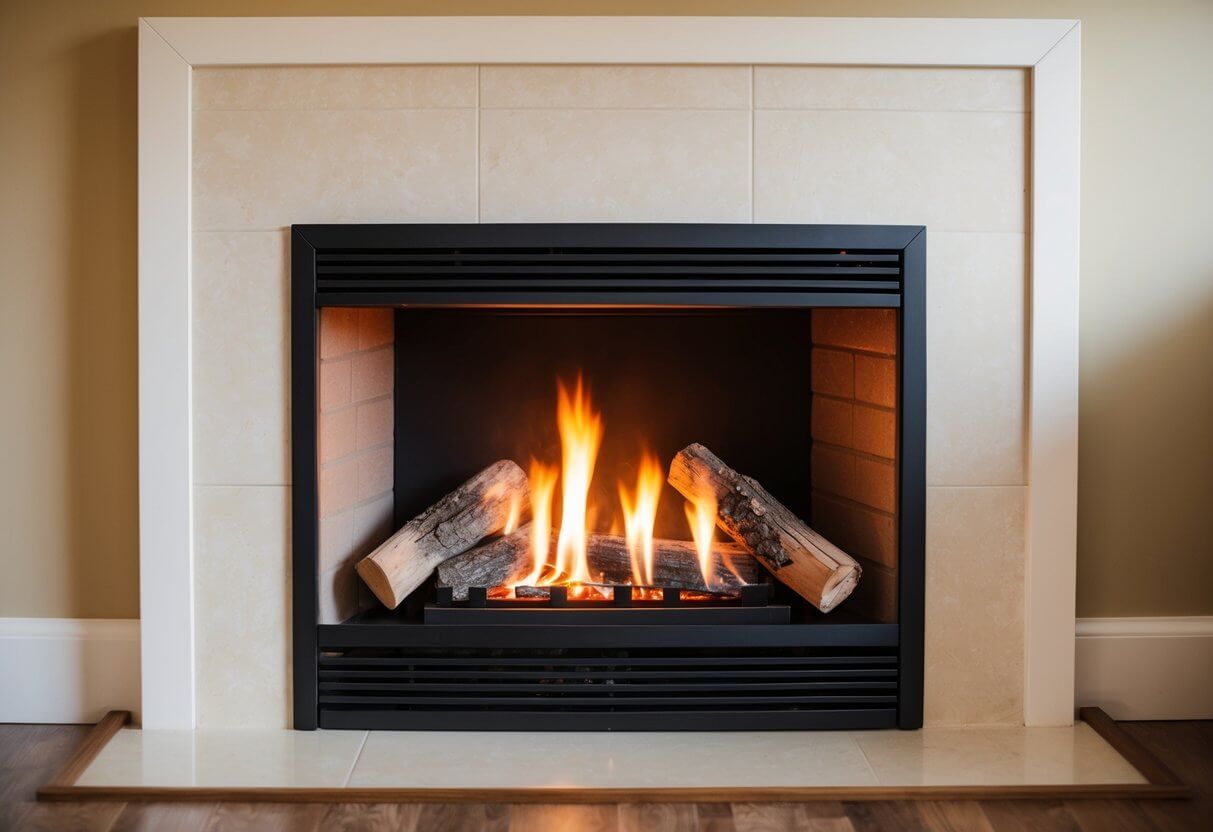
Gas fireplace logs come in various types and function in specific ways to ensure warmth and ambiance. Knowing the differences and how they operate helps in proper maintenance and timely replacement.
Types of Gas Logs
Gas logs are primarily categorized into vented and ventless options. Vented gas logs require a chimney or flue, allowing combustion gases to exit the home. They create a more authentic flame appearance and are often made of ceramic or refractory materials. These logs tend to produce more heat but are less efficient since much of the heat escapes outdoors.
In contrast, ventless gas logs do not need a venting system, making them suitable for sealed spaces. They burn cleaner and retain more heat, but they can produce more moisture and create air quality concerns if used excessively. When selecting gas logs, homeowners should consider factors such as energy efficiency, local regulations, and personal preferences for aesthetics.
How Gas Fireplaces Work
Gas fireplaces utilize a gas supply, most commonly natural gas or propane, delivered via a gas line. The ignition process begins when the gas is ignited using a spark or pilot light, producing flames that mimic traditional wood-burning fireplaces.
Components like burners, valves, and fireplace logs create a functional system. When gas flows to the burner, it mixes with air to facilitate combustion. These fireplaces are designed for safety and energy efficiency, utilizing thermocouples to regulate gas flow.
Maintenance is essential for proper function. Regular inspections ensure that gas lines and connections remain secure, preventing leaks. Homeowners should also monitor the condition of the logs for signs of wear, which can impact safety and performance.
Signs You Need to Replace Gas Fireplace Logs

Maintaining gas fireplace logs is crucial for safety and efficiency. Homeowners should be attentive to specific warning signs indicating the logs may need replacement.
Physical Deterioration
Physical deterioration of gas logs is a clear sign that they require replacement. Homeowners should inspect the logs regularly for cracks, chips, or discoloration. Such damage can affect both performance and safety.
If cracks are present, they may allow gas leaks, which pose serious hazards. Additionally, visible wear can lead to uneven heating and reduced efficiency in the fireplace. If the logs start to crumble or lose their structural integrity, they should be replaced without delay. Inspecting logs at least once a year, especially before the fireplace season begins, can help catch these issues early.
Inconsistent Flame Patterns
Inconsistent flame patterns can signal the need for new gas logs. Flames that flicker, burn too low, or fail to ignite properly can indicate that the logs are not functioning efficiently.
This inconsistency may arise from blockages or degradation of the logs themselves, impacting the overall heating performance. Uneven flames can also create unsafe conditions, potentially increasing the risk of gas buildup. Monitoring flame behavior while using the fireplace can help identify problems early. If noticeable changes occur, it’s advisable to consult a technician for evaluation and possible log replacement.
Odd Odors or Sounds
Unusual odors or sounds can indicate a problem with gas fireplace logs. If a homeowner detects a gas smell, this is an urgent warning sign of a potential gas leak, necessitating immediate action.
In addition, if the logs produce odd noises, such as popping or cracking sounds, this may indicate structural damage. Such sounds often suggest that the logs are deteriorating or improperly aligned. Homeowners should prioritize their safety by addressing these issues quickly. If any unusual symptoms arise, it is wise to contact a professional for a thorough inspection and guidance on replacing the logs.
Choosing the Right Replacement Logs
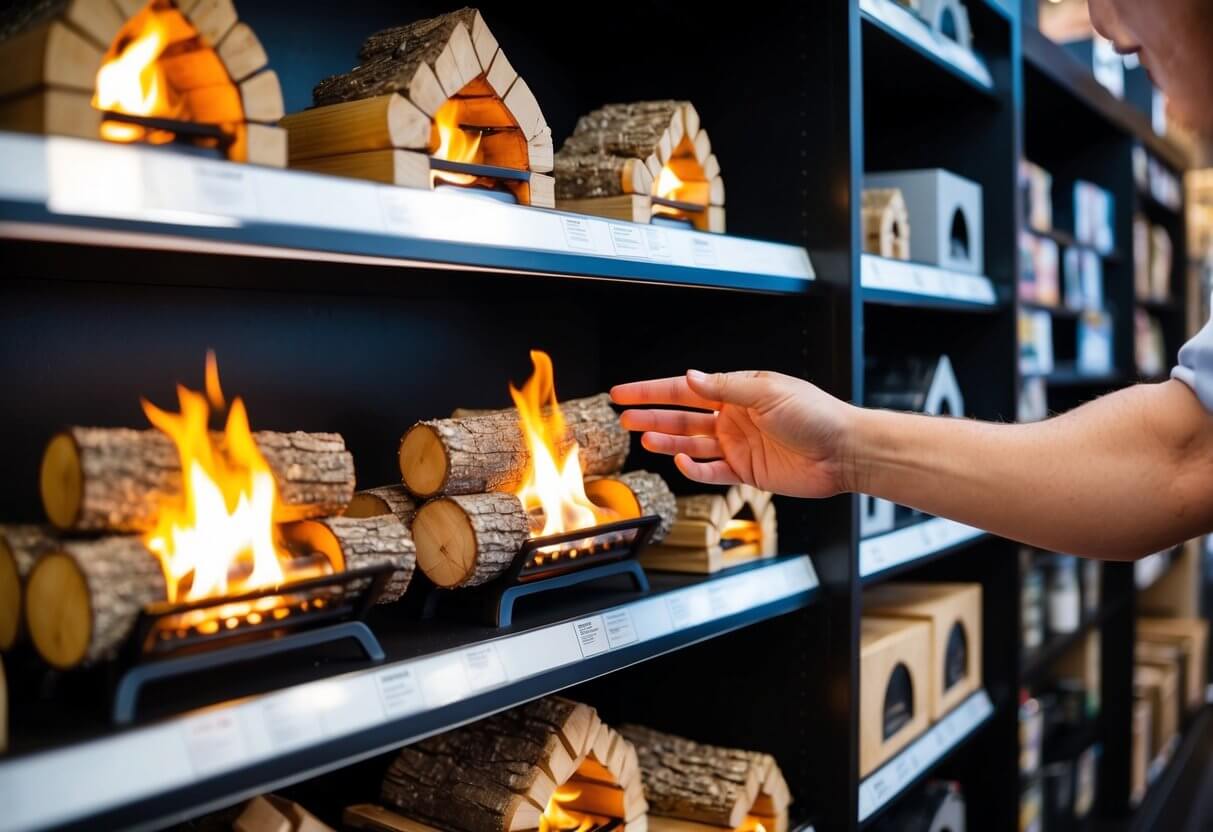
Selecting the correct replacement logs for a gas fireplace involves several important considerations. It is essential to evaluate the material and quality of the logs, ensure compatibility with the gas supply, and consider aesthetic preferences.
Material and Quality
The material used in gas logs significantly influences their durability and performance. Common materials include:
- Ceramic: Known for its ability to withstand high temperatures, ceramic logs retain heat well and provide a realistic appearance.
- Refractory Cement: This option offers durability against heat and is often used in vented log sets for its ability to mimic the look of real wood.
- Cast Iron: While less common, cast iron logs offer a unique appeal and excellent heat retention.
Choosing high-quality materials ensures the longevity of the logs and their effective performance, especially in terms of heat output and flame aesthetics. It’s advisable to review manufacturer specifications and customer reviews to determine the best options.
Compatibility with Your Gas Supply
Before selecting replacement gas logs, one must confirm compatibility with the existing gas supply. Gas logs typically operate on either natural gas or propane. It is crucial to identify the type of gas in use since mixing the two can lead to safety hazards and inefficiency.
In addition, consider whether the gas log set is vented or vent-free. Vented logs require a functioning chimney, while vent-free logs can operate without one. Ensuring proper compatibility not only enhances performance but also ensures adherence to safety regulations. Always consult with a professional if uncertain about compatibility.
Aesthetic Considerations
The appearance of gas logs can greatly impact the overall ambiance of the fireplace. Available options include various styles and finishes:
- Realistic Wood Designs: Many products replicate the look of different types of wood, such as birch, oak, or driftwood, allowing homeowners to choose based on personal taste.
- Charred or Uncharred Options: Some may prefer the look of freshly cut logs, while others might opt for more rustic, charred styles.
Selecting logs that align with the existing decor results in a visually appealing setup. When choosing size, select from standard options, typically available in 18″, 24″, or 30″ lengths, to ensure a proper fit within the fireplace.
Installation and Maintenance Tips

Proper installation and regular maintenance are crucial for ensuring the longevity and efficiency of gas log sets in gas fireplaces. These practices not only enhance safety but also optimize performance, allowing for a warm and inviting atmosphere.
Professional Installation
Engaging a qualified professional for gas log set installation is vital. Experts are trained to handle the specific requirements for vented and vent-free fireplaces. They ensure compliance with local codes and manufacturer guidelines, minimizing risks of gas leaks or improper ventilation.
Key considerations during installation include:
- Positioning: Proper placement affects combustion efficiency.
- Ventilation: Adequate airflow prevents buildup of harmful gases.
- Sealing Connections: All joints must be tightly sealed to prevent leaks.
In addition, hiring a professional can result in a longer-lasting installation and may prevent costly repairs down the line.
Regular Maintenance Schedule
Establishing a regular maintenance schedule is essential for gas fireplaces. Regular check-ups help identify and address issues before they become serious problems. Maintenance tasks should include:
- Visual Inspections: Regularly check for any signs of wear or damage.
- Cleaning: Remove dust, debris, and soot to keep the log set functioning efficiently.
- Checking Connections: Ensure all gas connections are secure and free from leaks.
For vented fireplaces, consider scheduling maintenance every year. Vent-free models typically require more frequent attention, generally every 3 to 5 years. Staying vigilant can help maintain safety and performance, providing peace of mind for the homeowner.
Ensuring Safety and Efficiency
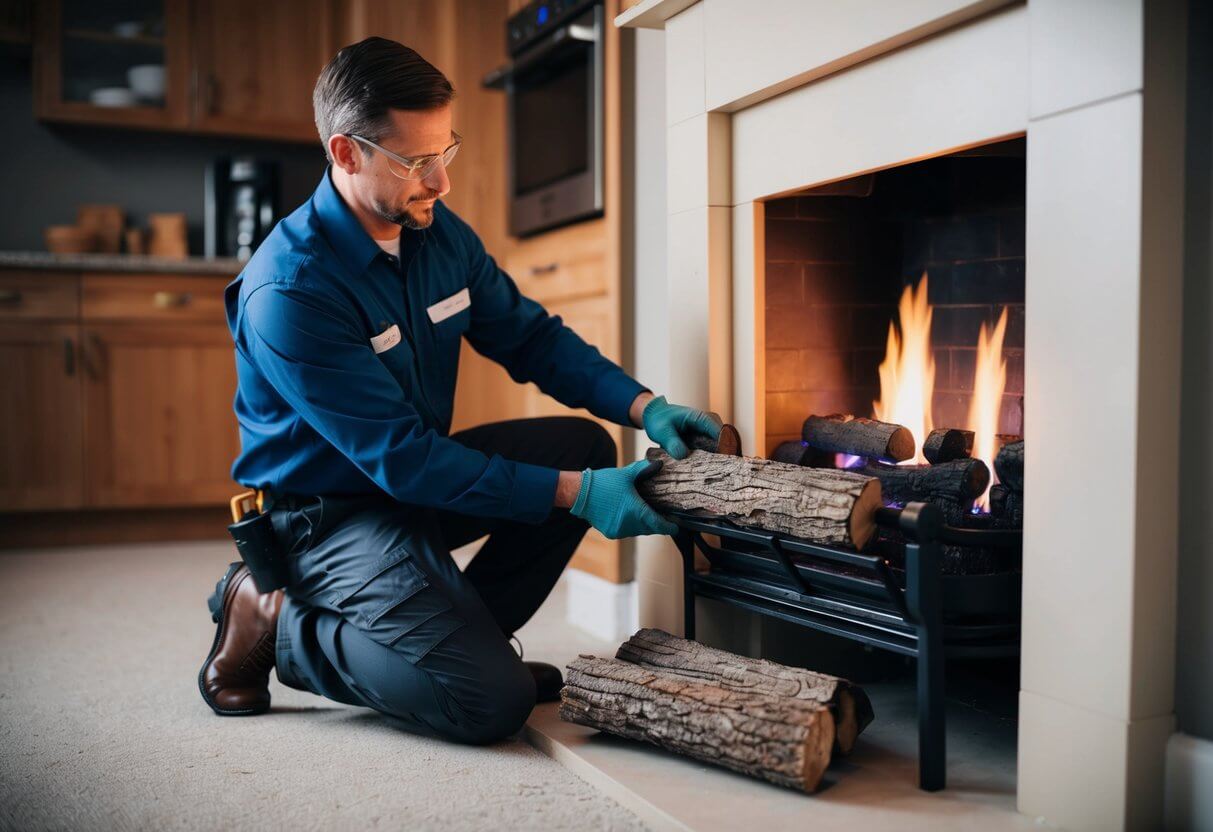
Proper maintenance of a gas fireplace involves addressing ventilation and ensuring adequate gas supply. Both factors are critical to maintaining safety and operational efficiency.
Proper Ventilation
Adequate ventilation is essential for the safe operation of a gas fireplace. Proper airflow prevents the buildup of harmful gases, such as carbon monoxide, and helps maintain optimal combustion efficiency.
To facilitate this, ensure that vents and chimneys are clear of obstructions. Periodic inspections should be conducted to check for any debris, animal nests, or blockages.
Key steps for ensuring proper ventilation include:
- Inspecting venting systems at least once a year.
- Installing quality venting materials to withstand high temperatures.
- Ensuring that air intakes are unobstructed.
Maintaining proper ventilation not only enhances safety but also improves heating efficiency, reducing energy costs over time.
Gas Supply and Pressure Checks
Regular checks of the gas supply and pressure are crucial to the fireplace’s performance. Gas supply should be consistent and adequate to avoid incomplete combustion, which can lead to safety hazards.
Homeowners should be aware of the following:
- Look for unusual odors or hissing sounds, which may indicate a gas leak.
- Monitor the gas pressure regularly and ensure it aligns with the manufacturer’s specifications.
Checklist for gas supply maintenance:
- Verify gas supply lines for wear or damage.
- Use a manometer to check gas pressure.
- Call a professional for any discrepancies or issues.
By ensuring a steady gas supply and proper pressure levels, gas fireplaces can operate safely and efficiently.
Frequently Asked Questions
This section addresses common inquiries related to gas fireplace log replacement. It provides clarity on maintenance practices, cost considerations, and the specifics of choosing logs for optimal performance.
How often should gas fireplace logs be replaced for optimal performance?
For vented gas fireplaces, logs should typically be replaced every 10 to 12 years. In contrast, vent-free fireplaces may require replacement every three to five years due to higher usage intensity.
What are the signs that indicate gas fireplace logs need to be switched out?
Signs of wear may include excessive soot buildup, cracks, or shifting logs that may affect combustion efficiency. Unusual odors or abnormal flames can also signal that it’s time for a replacement.
Is it more cost-effective to clean or replace gas fireplace logs?
Cleaning gas fireplace logs can extend their lifespan and improve performance. However, if logs are significantly damaged or worn, replacement may be more cost-effective in the long run, given the potential for reduced efficiency.
How does the replacement of gas fireplace logs differ from using stones?
Gas logs are designed specifically for gas units and provide a realistic flame appearance. Stones can be used in certain setups but may not produce the same visual effect or efficiency in burning as engineered logs.
What considerations should be made when choosing new logs for a gas fireplace?
When selecting new logs, factors such as size, material, and compatibility with the fireplace model are crucial. It’s important to ensure the logs meet safety standards and installation guidelines.
What is the typical lifespan of gas fireplace logs under normal use?
Under typical circumstances, gas fireplace logs can last anywhere from 10 to 12 years for vented models. For vent-free models, the lifespan is shorter, ranging from three to five years based on usage and maintenance practices.

